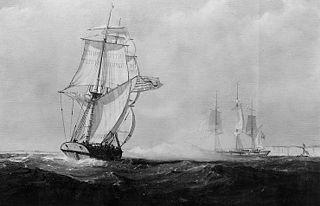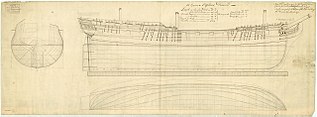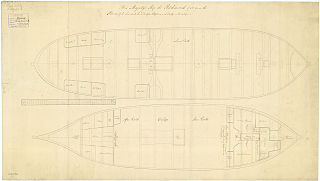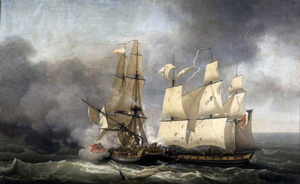
The second USS Revenge was a cutter in the Continental Navy and later a privateer.

The fourth HMS Diamond was a modified Lowestoffe-class fifth-rate frigate ordered in 1770, launched in 1774, but did not begin service until 1776. Diamond served off the eastern North American coast and shared in the capture at least one brig during the American Revolutionary War. The frigate was paid off in 1779, but returned to service the same year after being coppered. Diamond sailed to the West Indies in 1780, was paid off a final time in 1783 and sold in 1784.

HMS St Albans was a 64-gun third rate ship of the line of the Royal Navy, launched on 12 September 1764 by Perry, Wells & Green at their Blackwall Yard, London.
HMS Nonsuch was a 64-gun third rate ship of the line of the Royal Navy, built by Israel Pownoll and launched on 17 December 1774 at Plymouth. She was broken up in 1802.

HMS Badger was a brig rigged Sloop-of-War in service with the Royal Navy in the late eighteenth century. Badger is notable as being the first Royal Navy ship to be commanded by Horatio Nelson.
HMS Antigua was a 14-gun sloop that served in the British Royal Navy from 1779 to 1792. In contemporary records she is sometimes referred to as "His Majesty's armed brig Antigua".

HMS Carysfort was a 28-gun Coventry-class sixth-rate frigate of the Royal Navy. She served during the American War of Independence, the French Revolutionary and the Napoleonic Wars in a career that spanned over forty years.

HMS Lapwing was a 28-gun Enterprise-class sixth-rate frigate of the Royal Navy.

HMS Mermaid was a Mermaid-class sixth-rate frigate of the Royal Navy. She was first commissioned in April 1761 under Captain George Watson and built in Blaydes Yard in Kingston-Upon-Hull.

HMS Solebay was a Mermaid-class sixth-rate frigate of the Royal Navy which saw active service between 1766 and 1782, during the latter part of the Seven Years' War and throughout the American Revolutionary War. After a successful career in which she captured seven enemy vessels, she was wrecked ashore on the Caribbean Island of Nevis.

HMS Juno was a 32-gun Richmond-class fifth-rate frigate of the Royal Navy. She was launched in 1757 and served throughout the American Revolutionary War until scuttled in 1778 to avoid capture. On 5 June, 1777 she, HMS Juno, and HMS Orpheus recaptured privateer brig "Lucy" 15 Leagues off Nantucket. On 9 July, 1777 she captured Betsy in Boston Bay. On 9 January, 1778 she captured French snow David 3-4 miles off the north east tip of Block Island. She engaged USS Providence during Providence's escape from Providence, Rhode Island 30 April 1778.

HMS Richmond was the name ship of the six-vessel, 32-gun Richmond-class fifth-rate frigates of the Royal Navy. She was launched in 1757 and served throughout the American Revolutionary War. She and HMS Emerald captured French brig Alexandrine in Chesapeake Bay off the mouth of the Rappahannock River 3 January, 1778. She captured 1 prize off Cape Charles in February, 1778. On 5 February a sloop ran aground off Cherry Point while being pursued by Richmond and HMS Solebay and was burned. On 9 February Richmond and HMS Solebay captured Maryland State Govt. trading vessel Lydia off St. Mary's River, later ruled a recapture. On 28 February she captured Danish flagged, American owned ship Good Hope off Cape Henry. She was captured by the French 74-gun Bourgogne and the frigate Aigrette on 11 September 1781 in the Chesapeake. She then served as Richemont under Lieutenant Mortemart.

HMS Southampton was the name ship of the 32-gun Southampton-class fifth-rate frigates of the Royal Navy. She was launched in 1757 and served for more than half a century until wrecked in 1812.

HMS Milford was a 28-gun Coventry-class sixth-rate frigate of the Royal Navy. She was built at Milford by Richard Chitty and launched in 1759. She was sold for breaking at Woolwich on 17 May 1785.

HMS Blonde was a 32-gun fifth-rate warship of the British Royal Navy captured from the French in 1760. The ship wrecked on Blonde Rock with American prisoners on board. An American privateer captain, Daniel Adams, rescued the American prisoners and let the British go free. The captain's decision created an international stir. Upon returning to Boston, the American privateer was banished for letting go the British crew and he and his family became Loyalist refugees in Nova Scotia.

HMS Ceres was an 18-gun sloop launched in 1777 for the British Royal Navy that the French captured in December 1778 off Saint Lucia. The French Navy took her into service as Cérès. The British recaptured her in 1782 and renamed her HMS Raven, only to have the French recapture her again early in 1783. The French returned her name to Cérès, and she then served in the French Navy until sold at Brest in 1791.

Experiment was a 50-gun ship of the line of the British Royal Navy. Captured by Sagittaire during the War of American Independence, she was recommissioned in the French Navy, where she served into the 1800s.

HMS Glory was a 32-gun fifth-rate Niger-class frigate of the Royal Navy, and was the second Royal Navy ship to bear this name.

HMS Aeolus (1758) was a 32-gun fifth-rate frigate of the Royal Navy. In 1800, she renamed as HMS Guernsey.






















